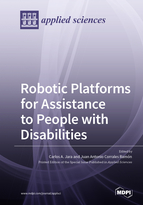Robotic Platforms for Assistance to People with Disabilities
A special issue of Applied Sciences (ISSN 2076-3417). This special issue belongs to the section "Robotics and Automation".
Deadline for manuscript submissions: closed (28 February 2021) | Viewed by 20691
Special Issue Editors
Interests: design and robot simulation; robotic manipulation; human–robot interaction; assistive and rehabilitation robotics
Special Issues, Collections and Topics in MDPI journals
Interests: human-robot interaction; robotic manipulation; multi-modal control; tactile sensing
Special Issues, Collections and Topics in MDPI journals
Special Issue Information
Dear colleagues,
People with congenital and/or acquired disabilities form a significant number of dependents in the current society. These patients lack enough autonomy to live an independent life. Robotic platforms for providing assistance to people with disabilities are being developed with the aim of providing both rehabilitation treatment and assistance in improving their quality of life, mainly applied to people who have mobility problems or some type of functional disability. The impact and capacity of assistance of collaborative robotics in this area has continuously improved the healthcare world in aspects such as chronic disease prevention, saving time for professionals, and lower spending for public health. In this sense, an important aspect to emphasize in these robotic assistance environments is the human–robot interaction. This topic demands sensitive and intelligent robotics platforms, equipped with complex sensory systems, high handling functionalities, safe control strategies, and intelligent computer vision algorithms.
The Special Issue of Applied Sciences “Robotic Platforms for Assistance to People with Disabilities” aims to cover recent advances in the field of robotic platforms to assist disabled people in daily or clinical environments. Papers should address innovative solutions in this field, including affordable assistive robotics devices, new techniques in control/computer vision for intelligent and safe human–robot interaction, exoskeletons or exosuits to assist people with mobility problems, and advances in mobile manipulators for assistive tasks.
Some topics include but are not limited to:
Assistive robots for people with disabilities in daily or clinical environments;
Human–robot interaction techniques for assistive environments;
Computer vision and control for human–robot physical interaction;
Interaction-aware motion planning with disabled people;
Exoskeletons or exosoft solutions for assistance;
Mobile manipulators for assistive tasks.
Dr. Carlos Alberto Jara
Dr. Juan Antonio Corrales Ramón
Guest Editors
Manuscript Submission Information
Manuscripts should be submitted online at www.mdpi.com by registering and logging in to this website. Once you are registered, click here to go to the submission form. Manuscripts can be submitted until the deadline. All submissions that pass pre-check are peer-reviewed. Accepted papers will be published continuously in the journal (as soon as accepted) and will be listed together on the special issue website. Research articles, review articles as well as short communications are invited. For planned papers, a title and short abstract (about 100 words) can be sent to the Editorial Office for announcement on this website.
Submitted manuscripts should not have been published previously, nor be under consideration for publication elsewhere (except conference proceedings papers). All manuscripts are thoroughly refereed through a single-blind peer-review process. A guide for authors and other relevant information for submission of manuscripts is available on the Instructions for Authors page. Applied Sciences is an international peer-reviewed open access semimonthly journal published by MDPI.
Please visit the Instructions for Authors page before submitting a manuscript. The Article Processing Charge (APC) for publication in this open access journal is 2400 CHF (Swiss Francs). Submitted papers should be well formatted and use good English. Authors may use MDPI's English editing service prior to publication or during author revisions.
Keywords
- assistive robots for disabled people
- human–robot interaction
- assistive robotic exoskeletons or soft exosuits
- assistive mobile manipulators
- user-centered design of robotic platforms







